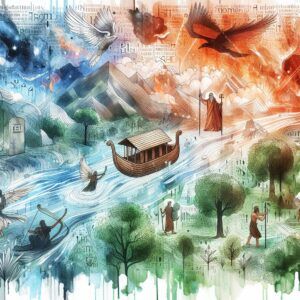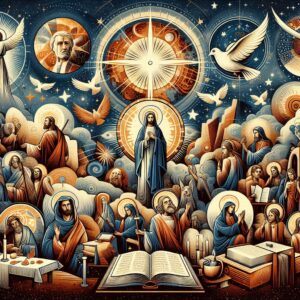I’m going to lay down the groundwork for understanding the Bible’s two main sections: the Old Testament and the New Testament. These aren’t just separate parts of a religious text; they’re, in essence, two covenants that provide a deep, historical, and theological framework underpinning the Judeo-Christian faith.
The Old Testament sets the stage with stories that span creation to the prophets, forming the core of Jewish scripture and also serving as the foundation for Christian theology. It’s like a vast library containing history, poetry, moral teachings, and prophecies. With gripping narratives such as Adam and Eve, Noah’s Ark, and Moses facing down Pharaoh, it captures the imagination and wrestles with profound questions of humanity and divinity.
Then, there’s the New Testament, which shifts the focus from anticipation to fulfillment. It’s centered around the figure of Jesus Christ — his work, his teachings, and the spiritual revolution he ignited, which has influenced countless lives for millennia. This section of the Bible brings a message of redemption, love, and a personal relationship with God through Jesus.
Throughout this article, you’re going to find out about distinct aspects that set these two Testaments apart — from differences in content and focus to the prophecies, covenants, and even the languages they were originally written in. It’s not just about recounting storied texts; it’s also about understanding how they shape beliefs, morals, and the very fabric of religious experience for millions around the world.
Now, as we proceed, keep in mind that both Testaments are integral to Christian theology. While they may differ in various ways, they come together to form a unified narrative. In that spirit, let’s move forward to the next section, where we’ll detail the Old Testament’s content, structure, and its distinctive emphasis on law and prophecy.
Exploring the Old Testament: Covenant, Law, and Prophecy
The Old Testament isn’t just a prelude to the New; it’s an intricate mosaic of narratives, laws, and oracles that shape the foundation of Judeo-Christian thought. Comprising 39 books, this collection is more than just a historical account; it is divided thoughtfully into different types of writings: the Torah, Historical Books, Wisdom Books, and Prophetic Books.
You’re going to find out about iconic biblical figures and monumental events that stood the test of time. From the Genesis account of Adam and Eve to the towering figure of Moses who leads the Israelites out of Egypt with the help of wonderous signs – the opening of the Red Sea being one of the most awe-inspiring.
These books tell tales of epic survival, capture vast sweeps of history, convey moral teachings through poetry, and relay prophecies. There’s a strong emphasis on the might of God, His wrath, and judgment, yet these pages also portray a deity unwaveringly faithful to His covenant with humanity.
A few scriptures give you a glimpse into the vast array of literature found within the Old Testament. Genesis 1:1-31 illustrates the poetics of creation, while Exodus 14:21-22 recounts the grandeur of divine intervention. The Ten Commandments in Exodus 20:1-17 serve as the bedrock of Judaic moral code, and passages like Isaiah 1:18 invite us to reason and seek righteousness.
The Wisdom literature, including works like the Song of Solomon, allows us to dive into the depths of love, while prophecies such as those found in Isaiah offer hopeful anticipation for redemptive futures. It’s this dynamic blend of history and hope, wrath and redemption, that sets the stage for what is to come in the New Testament.
Unveiling the New Testament: Christ’s Mission and the New Covenant
Moving from the ancient texts of the Old Testament, you’re going to find out about the New Testament’s 27 books, which present a transformative narrative. This isn’t just about history; it’s also about the advent of a new spiritual era. The New Testament divides into the Gospels, the Epistles, and Revelation, each offering a unique lens through which to view the life and works of Jesus Christ.
At the heart of the New Testament is the life, teachings, crucifixion, and resurrection of Jesus. These events are pivotal, marking the transition from the Old Testament’s expectation to the New Testament’s realization of the Messiah. Emphasizing themes of grace, inclusivity, and spiritual fulfillment, the New Testament provides not only historical accounts but also profound theological insights.
One of the most powerful expressions of this shift is the concept of grace, as demonstrated in John 3:16, stating that ‘God so loved the world that He gave His only Son.’ This scripture captures the inclusivity and the expansive love that the New Testament embodies. Another significant scripture, Romans 3:21-26, highlights the righteousness from God that comes through faith in Jesus Christ to all who believe.
Don’t worry too much about trying to separate the value of the two Testaments; instead, choose something that resonates with you from both. They are intertwined narratives that speak to an evolving relationship between God and humanity. In recognizing Jesus as the anticipated Messiah of the Old Testament, the New Testament authors depict Him as the foundation of a New Covenant, affirming His teachings as the way to spiritual truth and fulfillment.
Contrasting Testaments: An Examination of Distinct Perspectives
The differences between the Old and New Testaments go beyond their content and messages. They reflect contrasting perspectives shaped by different historical times, cultural contexts, and divine revelations.
The time period difference is stark. The Old Testament was written from the time of Moses until about 400 BC, covering an era of approximately 1,000 years. In contrast, the New Testament was penned in a much shorter timeframe, between around AD 50 and AD 100, and covers the founding events of Christianity.
In terms of focus, the Old Testament chronicles God’s tremendous works and power, with a forward-looking perspective toward the coming Messiah. It’s in these ancient texts that we find stories of survival, judgment, and ethical teachings woven through history. Conversely, the New Testament centers on revealing Jesus as the long-awaited Messiah, drawing on His life and teachings as the foundation for the church’s formation and the gospel’s proliferation.
When examining prophecies, the Old Testament is laden with ones that looked to the future, remaining unfulfilled at the time they were written. It teems with the expectation of deliverance and redemption. The New Testament scriptures often refer back to these predictions, illustrating how they culminated in Jesus Christ’s life and actions, underscoring their fulfillment and bringing a sense of supernatural completion to the text.
 Worship practices further distinguish the two. The Old Testament focused on the physical edifices of the tabernacle and the temple, with elaborate protocols for offerings and festivals. These were tangible expressions of faith. The New Testament, however, introduces a radical shift with Jesus presenting Himself as the ultimate focus of worship, obviating the need for a temple made with hands and redefining access to the divine.
Worship practices further distinguish the two. The Old Testament focused on the physical edifices of the tabernacle and the temple, with elaborate protocols for offerings and festivals. These were tangible expressions of faith. The New Testament, however, introduces a radical shift with Jesus presenting Himself as the ultimate focus of worship, obviating the need for a temple made with hands and redefining access to the divine.
The covenants are perhaps the most significant difference. The Old Testament delves into the Mosaic covenant, highlighting obedience to the Law of the Lord as the path to righteousness. The New Testament presents a new covenant where Jesus consummates the Law, offering forgiveness and eternal life to those who put their faith in Him.
The obvious size difference is notable: the Old Testament constitutes about three-fourths of the entire Bible with its 39 books, while the New Testament holds 27 books. Yet the vocabulary used in each Testament also varies; you have a larger collection of words in the Old Testament, amounting to 5,800 words, while the New Testament contains a vocabulary of around 4,800 words.
The content focus also differs markedly. The Old Testament lays the foundations with accounts of creation, the exodus from Egypt, and the establishment of the Ten Commandments, alongside prophecies concerning a future Messiah. The New Testament, however, tells us about Jesus’ life and ministry, the birth and growth of the Christian church, and prophecies concerning the end of the world and the final judgment.
Another difference lies in language. Hebrew, with a small portion in Aramaic, was the language predominantly used to write the Old Testament. Greek, the common tongue of the Eastern Mediterranean heritage at the time, was used to author the New Testament.
Lastly, the purposes of the two Testaments, while related, emphasize different aspects of God’s interaction with humanity. The Old Testament is an intricate tapestry of God’s precepts, His relationship with His chosen people, and a roadmap to redemption amidst recurrent apostasy. The New Testament urges us to live a life that mirrors Jesus, glorifies God, and marks the inauguration of a new relationship between the divine and humankind, with Jesus as the cornerstone.
With these distinctions laid out, we can transition to understanding how the Old and New Testaments, despite their differences, come together to present a comprehensive narrative for Christians today. This understanding is pivotal for grasping the depth of both covenants and the evolution of faith practices through the ages.
The Testaments Together: Understanding the Complete Christian Narrative
I’m going to bring it all together for you. The Old Testament and New Testament aren’t just two separate collections of ancient texts; they’re complementary pieces of a larger narrative that has shaped the faith and practice of millions.
You’re going to find out that, despite their differences, these Testaments have a unified purpose. They tell a continuous story of redemption, from God’s creation and the fall of man to the promise of redemption through the Messiah in the Old Testament and its ultimate fulfillment in Jesus Christ in the New Testament.
This isn’t just about a collection of historical events or religious mandates; it’s also about a deeper understanding. The Old Testament sets the stage, building the expectation of a savior, while the New Testament reveals that savior and lays out the path for a faith-filled life.
In my opinion, appreciating how both Testaments work together is crucial for a full grasp of the Christian message. The Old Testament’s laws, prophecies, and stories find their completion and ultimate significance in the life, death, resurrection, and teachings of Jesus.
Choose something that resonates with you from these writings. Whether it’s the poetic wisdom of the Psalms, the epic narratives of the Pentateuch, or the revolutionary love exhibited in the Gospels, let the Testaments guide you toward understanding the heart of the Christian faith.
A lot is happening very quickly when you read through the Bible, from creation to revelation. The key is to engage with it not just as an ancient document, but as a living, breathing source of wisdom that continues to inform and inspire.
Your first attempt doesn’t need to be your last when it comes to understanding the Bible. It’s a lifelong journey that evolves with study, reflection, and experience. As the narratives of the Old and New Testaments intertwine, they offer a rich tapestry of insight and instruction for anyone on the quest for spiritual truth.
I really hope that you’ve gained insight into the integrated nature of the Old and New Testaments. They are not only foundational texts for Christianity, but they also offer timeless wisdom, perspective, and a call to transformation that is as relevant today as it was thousands of years ago.


